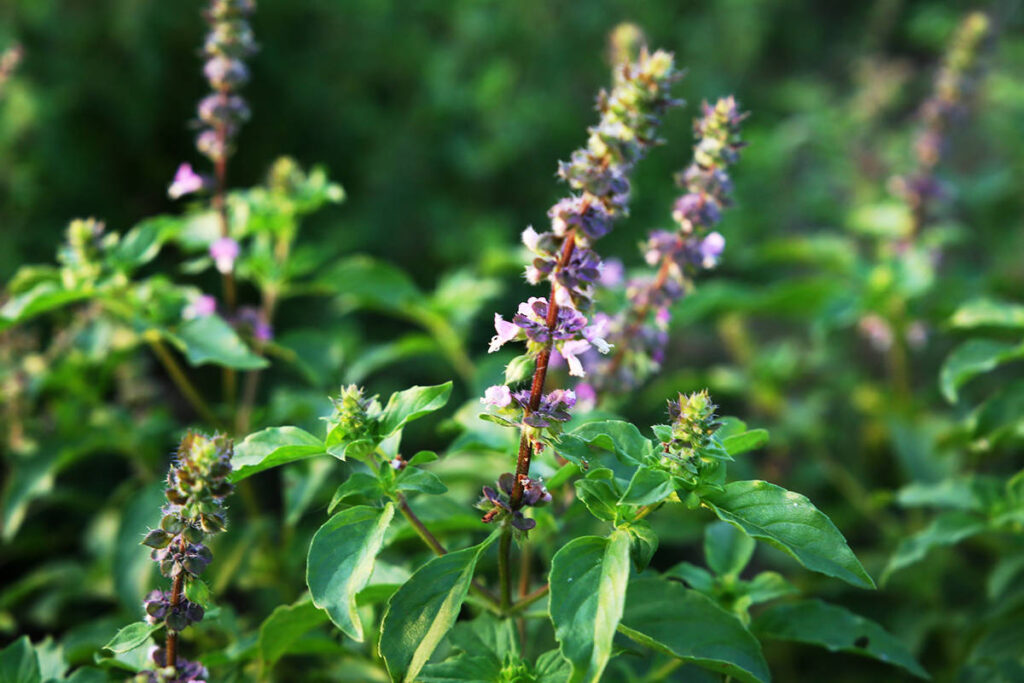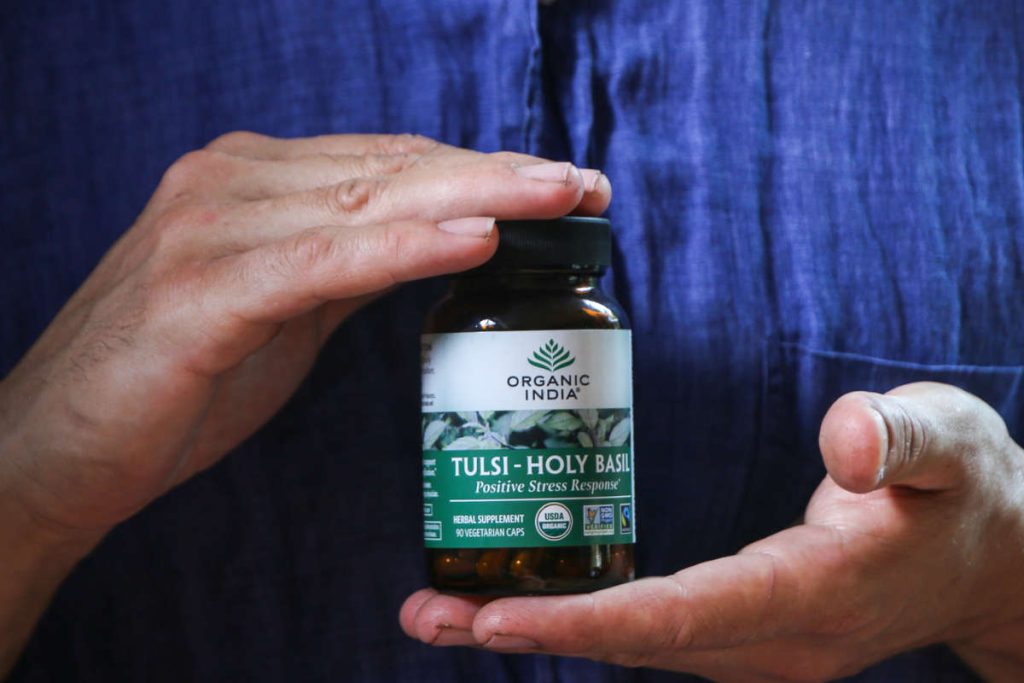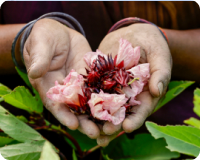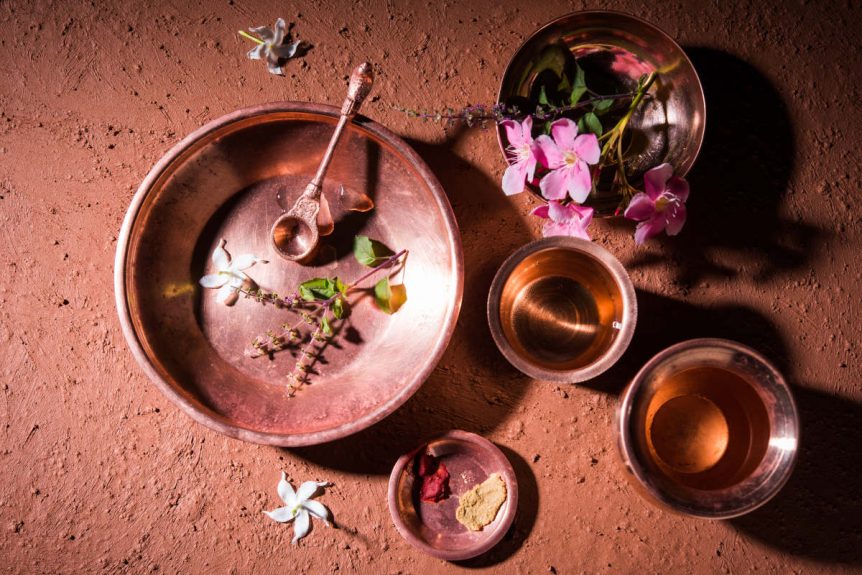

Section

Back
In the midst of our busy lives, we often yearn for the simple moments, something that reminds us of inner stillness, connection and a time to relax beyond our busy to-do list. This is when I think of Tulsi (Holy Basil) a sacred plant whose roots reach deep into ancient wisdom and remind me of a spiritual peacefulness. If I were to be a plant, I would choose to be Tulsi for all that she embodies.
Growing up in India, I recall Tulsi being the plant of every home, revered for its sacredness and medicinal and healing properties for thousands of years, Tulsi is known as the “Queen of herbs”. I remember my mother giving me some tulsi leaves to chew on to begin the day. Beyond its physical benefits, Tulsi is a plant of deep spiritual significance. Tulsi in Ayurveda and ancient India tradition represents love, devotion and protection, the sattvic qualities that bring calm in our busy lives today.
What is Tulsi ?
Tulsi belongs to the basil family, yet its essence and purpose goes far beyond culinary use. Known for its warm, slightly spicy, and clove-like fragrance, Tulsi has been used for centuries in Ayurveda as a rasayana, an herb that rejuvenates balance to the entire system.
Modern science identifies Tulsi as an adaptogen, a plant that helps the body adapt to stress. What makes tulsi special is also that its benefits extend beyond the physical. It nourishes the nervous system, uplifts the mood, and supports a sense of inner peace and harmony.

Why is Tulsi so Sacred in India ?
In India, Tulsi is not just a plant, she is a living goddess. Many homes have a Tulsi plant placed in the courtyard or by the entrance, tended to with the daily offerings of light and water. This act of care is both practical and spiritual – Tulsi purifies the air and uplifts the energy of the home.
It is woven into countless myths and rituals. The festival of Tulasi Vivaha celebrates the symbolic marriage of the goddess Tulsi to Lord Vishnu, representing the sacred union of love, dharma and devotion. Through this story, Tulsi becomes more than an herb, she is an embodiment of the purity, love and grace for Lord Vishnu and continues to be a part of homes to remind us of those qualities.
Why is Tulsi called “Holy Basil” ?
The name “Holy Basil” captures Tulsi’s dual identity which is both botanical and sacred, While botanically related to the familiar sweet basil, Tulsi’s use has always been deeply spiritual. The term “holy” acknowledges its sacred presence in India households and temples, where Tulsi leaves are used in worship, purification and daily rituals.
To this day, Tulsi is offered to deities, and planted in temple courtyards. It’s called holy not only for its divine associations but also for its ability to sanctify whatever it touches, from a sip of tea to the air around it.

What Goddess is Associated with Tulsi
Tulsi is regarded as the earthly manifestation of the goddess Lakshmi, the goddess of abundance, love and prosperity, and the beloved consort of Lord Vishnu. In many traditions, Tulsi herself is worshipped as Tulsi Devi, a goddess of devotion and spiritual purity.
According to legend, Tulsi’s unwavering devotion to Vishnu transformed her into a sacred plant, allowing her presence to remain on earth as a blessing to all beings. In this way, Tulsi symbolizes devotion in its purest form, love that transcends ego and merges with the divine.

The Divine Timing of Tulsi and Diwali
As I write this, it feels like divine timing that this piece on Tulsi is coming to life around Diwali – the Festival of Lights celebrated in India, when we invoke Goddess Lakshmi, the same divine essence that Tulsi carries. During Diwali, lamps are lit to honor the triumph of light over darkness and to invite abundance, light and grace into our homes, not merely material wealth but the radiance of peace and devotion. Across India, Tulsi and Lakshmi are both seen as embodiments of sacred feminine energy – nurturing, protective, heart led.
One of the traditional ways of expressing devotion at this time of Diwali, is through an offering known as Charna Amrit, translated as “nectar at the feet”. It symbolized humility, gratitude and reminds us that the sweetest form of abundance arises from trust and surrender in the divine. Each ingredient represents the five tattvas, the elements that form the foundation of all creation, also reminding us that true abundance is born from harmony with nature.
Traditional Charna Amrit Recipe
- Milk – nourishment ( earth tattva)
- Honey – sweetness (water tattva)
- Ghee(clarified butter) – inner radiance (fire tattva)
- Yogurt – purity ( air tattva)
- Jaggery – sweetness of divine love (ether tattva)
- Tulsi leaf – blessing for the offering
All the ingredients are mixed with intention and a small portion is offered to the divine during the puja(prayer) and then consumed as an act of receiving grace and blessings. Over time, I’ve created my own version of this sacred nectar, one that still honors the elements.
Radhika’s Charna Amrit (Sacred Nectar) Recipe
- Half a cup of greek yogurt – nourishing
- 1 tsp of honey – sweetness
- ¼ tsp Tulsi powder – purification (2 capsules, twisted open)
- Pinch of cardamom – for warmth
- 1 tsp of chopped almonds – for strength
- A few strands of saffron for radiance
Writing about Tulsi in Ayurveda during Diwali feels like divine timing and a living prayer, a reminder that devotion doesn’t require grand gestures. It lives in the sip of tulsi tea, intentional rituals that bring about grounding.

Does Tulsi Absorb Negative Energy ?
For centuries, Tulsi has been believed to purify and protect. In traditional homes, a Tulsi plant is placed near the entrance or courtyard to absorb negative energy and radiate vibration. Beyond superstition, this belief speaks to the plant’s role as a purifier both to the atmosphere and to the inner self.
Caring for a Tulsi plant can be an act of mindfulness, a way to cleanse mental clutter, release heaviness and bring back harmony. Whether you see this as a spiritual energy or simply a shift in your own being, Tulsi helps clear the subtle spaces within and around you.
Is Tulsi a Lucky Plant for the Home ?
Tulsi is regarded as highly auspicious. It is said to bring blessings, harmony and good fortune. Tending to Tulsi daily, offering water, lighting a small lamp nearby or simply stopping to breathe in its fragrance, all considered ways to invite divinity and grace into one’s life.
Where to Place Tulsi In the Home
Traditionally, Tulsi is planted in a central courtyard or near the home’s entrance, where it can receive morning sunlight. If you’re growing it indoors, choose a bright window, where it can thrive. Treat it with love, water it with intention, keep it clean and let it become a part of your morning ritual.

How to Use Holy Basil Spiritually
There are many ways to bring Tulsi into your spiritual practice
- Morning Ritual – Begin your day with a cup of Tulsi Tea. Take a few mindful breaths as you do, and set an intention for the day
- Plant Care – If you have a live Tulsi plant, tending to it can become a meditation itself, a daily ritual of devotion and gratitude.
- Sacred Offering – In temples and homes, Tulsi leaves are offered during prayers. You can adapt this practice by placing a leaf on your altar or simply holding it to your heart before meditation.
- Cleansing Ritual – Diffusing tulsi essential oil can be used to clear energy and space
- Mindfulness Moments – A few moments of stillness while sipping Tulsi tea can be a spiritual practice, a way to return to your center in the midst of the day.
Tulsi in Ayurveda
Tulsi in Ayurveda is considered a healing plant, one that balances the doshas and promotes longevity. It’s particularly valued for its effect on the nervous systems, its ability to strengthen immunity and its capacity to bring mental clarity.
Energetics of Tulsi
- Taste(Rasa) – Pungent, bitter
- Energy (Virya) – Warming
- Post Digestive effect (Vipaka) – Pungent
- Qualities (guna) – Light, dry, sharp
- Effects on Dosha – Balances kapha, and vata, pacifies excess Pitta in small doses
In Ayurveda, Tulsi is known to increase prana – the vital life force, while supporting digestion, circulation and clarity of mind. It’s often used in herbal teas and tonics, combined with ginger and black pepper to enhance its properties

Organic India’s Tulsi – A Sacred Partnership
At Organic India Usa, Tulsi is more than an ingredient, it’s a relationship rooted in reverence. The company works in long-standing partnerships with small family farmers in India who cultivate Tulsi through organic and regenerative practices.
Each leaf is hand-harvested with care, dried gently to preserve its natural potency, and blended into Organic India’s wide range of Tulsi Teas, supplements and herbal infusions. The commitment to Fairtrade and Regenerative Organic Certified® agriculture ensures that every sip supports wellbeing for the planet and the communities that nurture it.

In closing
Tulsi in Ayurveda teaches us that spirituality can live in the simplest of moments – while sipping the tea or tending to the care of the plant. It invites us to the sacredness of ritual in daily life. So the next time you hold a warm cup of Tulsi tea, pause and feel into its fragrance, its warmth, the feeling of love for yourself evoked from drinking any of the Tulsi Teas from Organic India USA. It is my most favorite ritual of the day and I hope you use it too as a reminder of your own inner temple bringing you calm and resilience in the moment.
To learn more about the wonders of Tulsi (Holy Basil), check out:
5 Surprising Tulsi Tea Benefits | Organic India
Tulsi vs Basil: What’s the Difference? | Organic India
What Makes Tulsi sacred? | Organic India
What is Tulsi? All About Holy Basil | Organic India
Also, try these Tulsi-blessed recipes:
Soothing Blue Moon Milk with Tulsi & Shatavari | Organic India
Tulsi Immunity Elixir with Neem | Organic India







 Radhika Mukhija is an integrative wellness mentor and meditation guide who empowers busy women to realize their full potential by blending ancient Ayurvedic wisdom with modern science. With over a decade of experience in coaching, Radhika helps clients achieve greater self-care, mental clarity and holistic wellbeing. Radhika is currently writing her debut book, set to be published by Shambhala. Radhika holds a Bachelor’s in Psychology, an MBA in Human Resources, is a certified yoga teacher, and has additional certifications in health coaching, Ayurveda, nutrition, and human potential coaching. Learn more about Radhika at
Radhika Mukhija is an integrative wellness mentor and meditation guide who empowers busy women to realize their full potential by blending ancient Ayurvedic wisdom with modern science. With over a decade of experience in coaching, Radhika helps clients achieve greater self-care, mental clarity and holistic wellbeing. Radhika is currently writing her debut book, set to be published by Shambhala. Radhika holds a Bachelor’s in Psychology, an MBA in Human Resources, is a certified yoga teacher, and has additional certifications in health coaching, Ayurveda, nutrition, and human potential coaching. Learn more about Radhika at